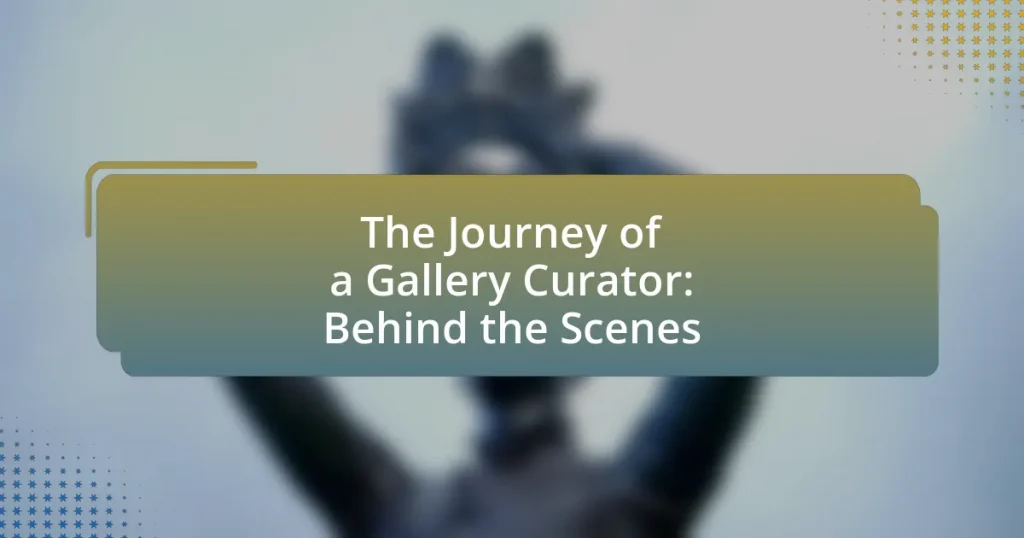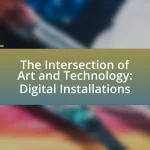The article focuses on the role of a gallery curator, detailing their responsibilities in selecting, organizing, and managing art exhibitions. It explores how curators contribute to the art world by enhancing public understanding and appreciation of art through thematic exhibitions. Key skills necessary for success, such as organizational abilities, art knowledge, and communication skills, are highlighted. The article also addresses the processes involved in curating exhibitions, including artwork selection, installation logistics, and audience engagement strategies, while discussing the challenges curators face, such as budget constraints and the need for collaboration. Additionally, it emphasizes the importance of networking and professional development resources for aspiring curators.
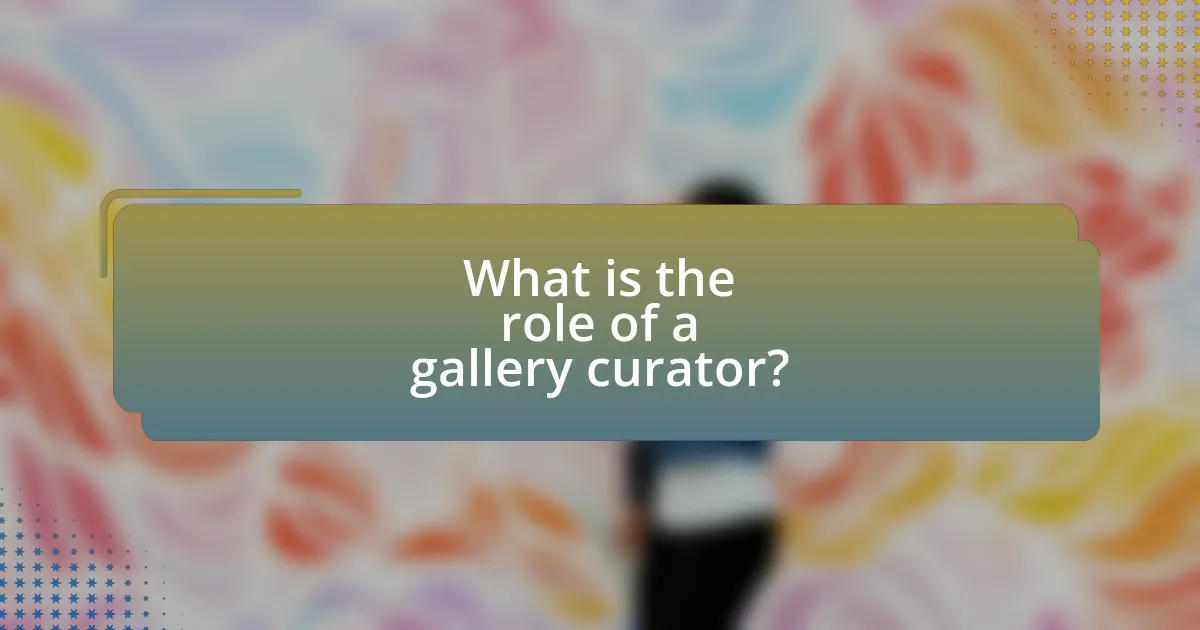
What is the role of a gallery curator?
A gallery curator is responsible for selecting, organizing, and managing art exhibitions within a gallery. This role involves researching artists and artworks, developing exhibition themes, and ensuring that the displayed works are presented in a way that engages the audience. Curators also handle logistics such as installation, lighting, and promotional materials, while often collaborating with artists, collectors, and other institutions to enhance the gallery’s offerings. The effectiveness of a gallery curator can be seen in the successful execution of exhibitions that attract visitors and foster appreciation for the arts.
How does a gallery curator contribute to the art world?
A gallery curator contributes to the art world by selecting, organizing, and presenting artworks in a way that enhances public understanding and appreciation of art. Curators play a crucial role in shaping exhibitions that reflect cultural narratives, trends, and artistic movements, thereby influencing how art is perceived and valued. For instance, curators often conduct extensive research to contextualize artworks, which can lead to increased visibility for emerging artists and underrepresented communities. Their expertise in art history and market trends allows them to make informed decisions that can elevate the status of certain works or artists, as seen in notable exhibitions like the Venice Biennale, which has historically launched the careers of many artists.
What skills are essential for a successful gallery curator?
Essential skills for a successful gallery curator include strong organizational abilities, art knowledge, communication skills, and networking capabilities. Organizational skills are crucial for managing exhibitions, collections, and events efficiently. A deep understanding of art history and contemporary art trends enables curators to make informed decisions about artwork selection and presentation. Effective communication skills are necessary for engaging with artists, collectors, and the public, while networking capabilities help curators build relationships that can enhance the gallery’s reputation and reach. These skills collectively contribute to the successful operation and impact of a gallery.
How does a gallery curator’s vision shape exhibitions?
A gallery curator’s vision shapes exhibitions by determining the thematic direction, selection of artworks, and overall narrative presented to the audience. This vision influences the choice of artists and pieces that align with the intended message, creating a cohesive experience that engages viewers. For instance, a curator may focus on contemporary social issues, leading to the inclusion of works that provoke thought and discussion around those themes. The curator’s expertise and perspective ensure that the exhibition not only showcases art but also communicates a specific viewpoint, enhancing the educational and emotional impact on the audience.
What are the key responsibilities of a gallery curator?
A gallery curator is primarily responsible for managing and overseeing art exhibitions and collections. This includes selecting artworks for display, organizing exhibitions, and ensuring the proper care and documentation of the collection. Curators also engage with artists, collectors, and the public to promote the gallery’s mission and enhance visitor experience. Additionally, they often conduct research on artworks and artists, write catalog essays, and develop educational programs related to the exhibitions. These responsibilities are essential for maintaining the gallery’s reputation and fostering a deeper appreciation of art within the community.
How does a gallery curator select artworks for exhibitions?
A gallery curator selects artworks for exhibitions by evaluating the thematic relevance, artistic quality, and audience engagement potential of the pieces. Curators often begin by defining the exhibition’s concept or theme, which guides their selection process. They assess artworks based on criteria such as originality, technical skill, and how well the pieces communicate the intended message. Additionally, curators consider the historical context and significance of the artworks, ensuring a diverse representation of styles and perspectives. This methodical approach is supported by industry practices, where curators frequently collaborate with artists, collectors, and other institutions to source and verify the artworks’ authenticity and relevance.
What processes are involved in organizing an exhibition?
Organizing an exhibition involves several key processes including conceptualization, planning, logistics, installation, and promotion. Conceptualization entails defining the theme and objectives of the exhibition, which guides the selection of artworks and artists. Planning involves creating a timeline, budget, and identifying the venue, ensuring all necessary resources are allocated effectively. Logistics cover the transportation and handling of artworks, as well as coordinating with artists and vendors for installation. Installation is the physical setup of the exhibition, where artworks are arranged according to the curator’s vision. Finally, promotion includes marketing the exhibition through various channels to attract visitors, which is essential for its success. Each of these processes is critical to ensure a cohesive and engaging exhibition experience.
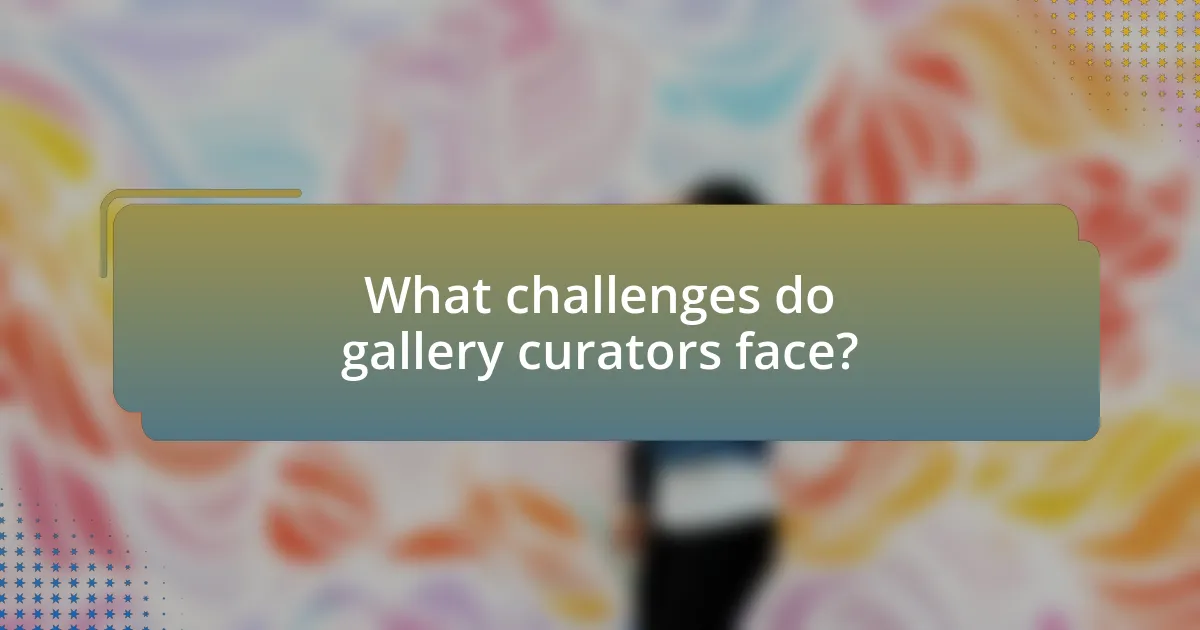
What challenges do gallery curators face?
Gallery curators face several challenges, including budget constraints, limited exhibition space, and the need to engage diverse audiences. Budget constraints often restrict the ability to acquire new artworks, leading to reliance on existing collections or loans, which can limit the scope of exhibitions. Limited exhibition space poses logistical challenges in displaying artworks effectively while ensuring visitor flow and safety. Additionally, engaging diverse audiences requires curators to balance artistic integrity with accessibility, necessitating innovative programming and outreach strategies to attract various demographic groups. These challenges are compounded by the evolving nature of the art market and changing visitor expectations, making it essential for curators to adapt continuously.
How do gallery curators manage budgets and funding?
Gallery curators manage budgets and funding by creating detailed financial plans that outline projected expenses and income sources. They assess costs related to exhibitions, including artist fees, installation expenses, marketing, and operational costs, while also identifying potential funding sources such as grants, sponsorships, and donations. Curators often collaborate with financial officers to ensure that spending aligns with the gallery’s overall financial strategy, and they may adjust budgets based on actual revenue and expenses throughout the exhibition cycle. This structured approach allows curators to maintain financial sustainability while delivering impactful exhibitions.
What strategies can curators use to secure funding for exhibitions?
Curators can secure funding for exhibitions by developing strong relationships with potential sponsors and grant-making organizations. Building a network of contacts in the arts community and beyond allows curators to identify funding opportunities that align with their exhibition themes. Additionally, curators can create compelling proposals that clearly outline the exhibition’s objectives, audience engagement strategies, and potential impact, which increases the likelihood of attracting financial support. Research indicates that exhibitions with well-defined goals and community involvement are more likely to receive funding, as evidenced by a study from the National Endowment for the Arts, which found that projects demonstrating community engagement received higher grant approval rates.
How do economic factors impact a curator’s work?
Economic factors significantly impact a curator’s work by influencing budget allocations, exhibition planning, and resource availability. For instance, limited funding can restrict the scope of exhibitions, forcing curators to prioritize certain artworks or themes over others. Additionally, economic downturns may lead to reduced visitor numbers, which can affect revenue from ticket sales and donations, further constraining a curator’s ability to acquire new pieces or invest in educational programs. According to a report by the American Alliance of Museums, 30% of museums reported budget cuts during economic recessions, highlighting the direct correlation between economic conditions and curatorial practices.
What role does collaboration play in a curator’s journey?
Collaboration is essential in a curator’s journey as it enhances the development and execution of exhibitions. Curators work with artists, collectors, and other professionals to gather diverse perspectives and resources, which enrich the overall narrative of the exhibition. For instance, a study by the American Alliance of Museums highlights that collaborative projects often lead to increased visitor engagement and satisfaction, demonstrating the tangible benefits of teamwork in curatorial practices.
How do curators work with artists and collectors?
Curators collaborate with artists and collectors by facilitating exhibitions and managing collections. They engage with artists to understand their work, often discussing themes, concepts, and logistics for showcasing art. Curators also build relationships with collectors to acquire pieces for exhibitions or to enhance the gallery’s collection, ensuring that the artworks align with the gallery’s vision and mission. This collaboration often involves negotiating loans, discussing provenance, and ensuring proper display and care of the artworks. The effectiveness of this collaboration is evident in successful exhibitions that attract audiences and enhance the visibility of both artists and collectors.
What partnerships are crucial for successful exhibitions?
Crucial partnerships for successful exhibitions include collaborations with artists, sponsors, and venue owners. Artists provide the core content and creativity essential for the exhibition, while sponsors offer financial support and resources that enhance the event’s visibility and reach. Venue owners contribute the physical space and logistical support necessary for hosting the exhibition. For instance, a study by the National Endowment for the Arts highlights that exhibitions with strong sponsorships see a 30% increase in attendance compared to those without. This demonstrates the importance of these partnerships in maximizing the impact and success of exhibitions.
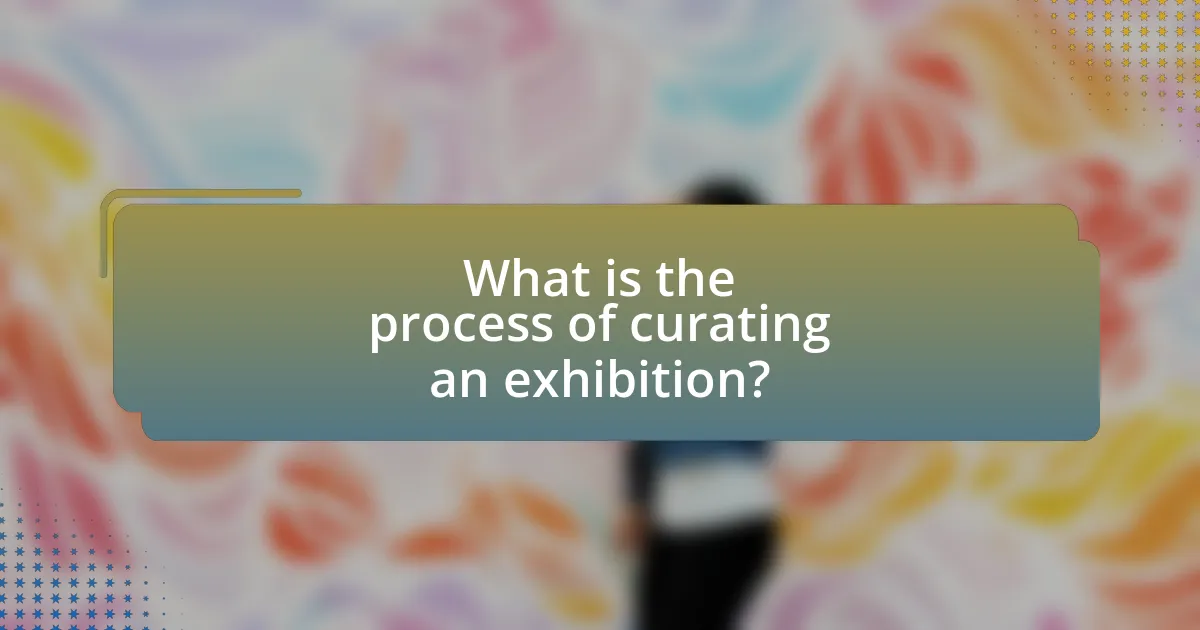
What is the process of curating an exhibition?
The process of curating an exhibition involves several key steps: conceptualization, selection, organization, and installation. Initially, the curator defines the exhibition’s theme or concept, which guides the selection of artworks. Following this, the curator researches and selects pieces that align with the theme, considering factors such as artistic merit, relevance, and audience engagement. After selection, the curator organizes the layout and flow of the exhibition, ensuring a cohesive narrative. Finally, the installation phase involves arranging the artworks in the exhibition space, paying attention to lighting, signage, and visitor experience. This structured approach ensures that the exhibition effectively communicates its intended message and engages the audience.
How do curators develop themes for exhibitions?
Curators develop themes for exhibitions by conducting extensive research on artistic trends, historical contexts, and audience interests. They analyze existing artworks, consider the narratives they wish to convey, and often collaborate with artists and other stakeholders to refine their vision. For instance, a curator might focus on a specific cultural movement or social issue, ensuring that the selected pieces resonate with the intended theme. This process is supported by data from visitor feedback and market analysis, which helps curators understand what themes engage audiences effectively.
What research methods do curators use to inform their choices?
Curators use a variety of research methods to inform their choices, including archival research, interviews with artists, and audience surveys. Archival research allows curators to explore historical documents, previous exhibitions, and collections to understand context and significance. Interviews with artists provide insights into their intentions and creative processes, enriching the curator’s perspective on the artwork. Audience surveys help curators gauge public interest and preferences, ensuring that exhibitions resonate with viewers. These methods collectively enhance the curator’s decision-making process, leading to well-informed and engaging exhibitions.
How do curators balance artistic vision with audience engagement?
Curators balance artistic vision with audience engagement by integrating contemporary themes and interactive elements into exhibitions. This approach allows curators to present their artistic concepts while ensuring that the audience finds the content relatable and engaging. For instance, curators often conduct audience research to understand preferences and interests, which informs their selection of artworks and the design of the exhibition space. Additionally, incorporating multimedia installations or participatory activities can enhance visitor interaction, making the experience more immersive. This strategy not only preserves the integrity of the artistic vision but also fosters a connection with the audience, ultimately leading to increased attendance and engagement.
What are the steps involved in installing an exhibition?
The steps involved in installing an exhibition include planning, designing the layout, preparing the space, installing artworks, and finalizing the presentation. Initially, curators develop a concept and select artworks, which informs the layout design. Next, the exhibition space is prepared by cleaning and arranging it according to the design. Following this, artworks are carefully installed, ensuring proper lighting and spacing for optimal viewing. Finally, the presentation is finalized by adding labels, signage, and any additional elements to enhance the visitor experience. Each step is crucial for creating a cohesive and engaging exhibition that effectively communicates the intended message.
How do curators decide on the layout and design of an exhibition?
Curators decide on the layout and design of an exhibition by considering the narrative they wish to convey, the relationships between artworks, and the physical space available. They analyze the thematic focus of the exhibition, selecting pieces that complement each other and create a cohesive story. Additionally, curators assess visitor flow and engagement, ensuring that the layout facilitates an intuitive experience. For instance, the Museum of Modern Art employs strategic placement to enhance viewer interaction, demonstrating how thoughtful design can influence perception and understanding of art.
What logistical considerations must curators address during installation?
Curators must address several logistical considerations during installation, including space planning, artwork handling, and timeline management. Space planning involves determining the layout of the exhibition to ensure optimal flow and visibility for visitors. Artwork handling requires careful consideration of transportation, installation techniques, and environmental conditions to prevent damage. Timeline management is crucial for coordinating the installation process, ensuring that all tasks are completed on schedule, which often involves collaboration with various stakeholders such as artists, technicians, and venue staff. These considerations are essential for a successful exhibition that meets both aesthetic and practical standards.
What best practices should aspiring curators follow?
Aspiring curators should prioritize building a strong network within the art community. Networking facilitates collaborations, access to resources, and opportunities for mentorship, which are crucial for career development. Additionally, curators should engage in continuous education about art history, contemporary practices, and exhibition techniques, as this knowledge enhances their ability to create meaningful exhibitions. Researching and understanding the audience is also vital; knowing what resonates with viewers can inform curatorial decisions and improve visitor engagement. Lastly, aspiring curators should document their projects and experiences, as maintaining a portfolio showcases their skills and growth in the field.
How can networking enhance a curator’s career opportunities?
Networking can significantly enhance a curator’s career opportunities by providing access to influential industry contacts and potential collaborators. Establishing relationships with artists, collectors, and other curators can lead to invitations for exhibitions, partnerships on projects, and recommendations for job openings. For instance, a study by the National Endowment for the Arts found that 70% of job placements in the arts sector occur through networking. This demonstrates that a well-connected curator is more likely to discover and secure career advancements compared to those who do not actively engage in networking.
What resources are available for professional development in curating?
Professional development resources for curating include workshops, online courses, and mentorship programs. Organizations such as the American Alliance of Museums offer workshops that focus on curatorial practices, while platforms like Coursera and edX provide online courses on art curation and museum studies. Additionally, mentorship programs through institutions like the Museum Association connect emerging curators with experienced professionals, facilitating knowledge transfer and skill development. These resources are validated by their widespread use in the field, enhancing the competencies of curators in various aspects of their roles.










